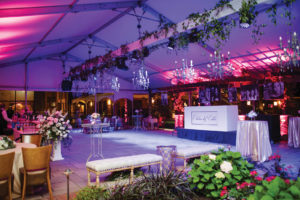
5-meter bay spacing and a choice
of 3-, 3.5- and 4-meter uprights.
Photo courtesy of Anchor Industries.
For Thomas Pollard, the introduction of clearspan structures in Canada has meant the difference between being able to install tents year-round versus closing up shop in the winter.
“What has changed up here [in western Canada] over the past 10 years is that there was no clearspan market 10 years ago,” says Pollard, vice president, Special Event Rentals, Edmonton, Alberta, Canada. Through its sales division, Pollard’s company is the U.S. and Canadian distributor of China-based Cosco Aluminum clearspan products.
“We have been creating a market for these structures because clearspans have brought in more opportunities versus the older pole tents,” Pollard says. “They give a rental company more options when there are space and anchoring restrictions, and the customer can now utilize space that is not suited to pole tent installation. What really has changed is that I’ve seen a big trend in more Asian-manufactured clearspans, as they have a huge cost advantage over the European and North American manufactured tents.”
Biff Gentsch, national sales manager, Anchor Industries Inc., Evansville, Ind., describes the growth of the clearspan market in North America as “dramatic.”
“Fifteen years ago there were only a handful of companies offering clearspan structures in the U.S. market,” he says. “Anchor Industries had the foresight to see the potential and viability for growth of these products. In 2004, Anchor teamed up with Röder AG [based in Germany] and began to address the changing U.S. market, pushing to educate the market to the advantages.”
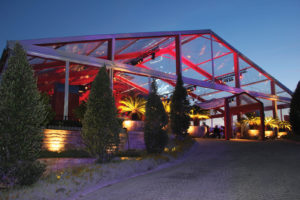
Keith Krzeminski, executive vice president, Shelter Structures America Inc., the North American distributor of clearspan structures manufactured by China’s Shelter Manufacturing Co. Ltd., says that clearspan products are now readily available from local rental suppliers in almost every market.
“Ten years ago clients would [have needed to] ship in materials from larger markets to fulfill their clients’ needs,” he says. “This growth can be attributed to several factors: from product awareness in the industry, safety concerns, to the availability of clearspan products from several domestic and international manufacturers and suppliers. Improved technology has allowed for the large growth in the quantity of suppliers and the simplification of the manufacturing process.”
As the style has taken hold and spread throughout North American rental companies, its success has further contributed to its own market growth, according to Nate Brancato, president of Liri Tent US, the U.S. clearspan supplier of China-based Liri Tent Technology.
“Because the number of companies utilizing engineered structures is expanding, the opportunity to sub-rent and coordinate large events and installations is much broader than may have previously existed,” Brancato says. “All of this has resulted in a knowledgeable client base and future client base that is rapidly expanding beyond traditional tents styles, and we know this growth will continue.”
More than a tent
Clearspans aren’t just for massive tenting anymore—they can be built as small as 10 feet wide. The structures are favored for their ability to meet codes and ease of permitting. The pole-free interiors offer a refined space, and the height of the sidewalls gives the structures a more expansive feel than other tent styles. Opportunities for exterior branding are another plus.
So, besides all of these great features, what does a tent rental company get for the investment?
There is a lot more to a clearspan than just buying a product for rental inventory, says Joe Langehaug, regional sales manager for Losberger U.S. LLC, the U.S. division of clearspan manufacturer Losberger De Boer Group, based in Germany. When tent rental companies invest in clearspan inventory, they are investing in the manufacturer’s quality of product, engineering, network, service after the sale and training on the jobsite, he says.
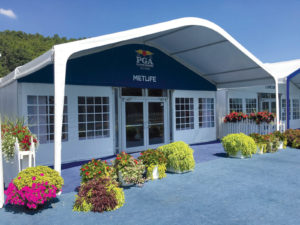
“New manufacturers recognize the popularity in clearspan and enter the market thinking it looks easy to make a clearspan tent,” Langehaug says.
“The issues that some customers are having with these new manufacturers concern obtaining the support needed after the sale. Local municipalities are becoming stricter on permitting and requiring documents in order to issue permits. Some manufacturers can’t provide the proper engineered documentation and leave their clients having to fend for themselves.”
Brancato lists durability, ease of use, high-quality finish and the look of the product as key features to consider when investing in a clearspan brand.
“In addition, [tent rental companies] require product support and the access to replacement and expansion parts,” he says. “Innovative design is important as well, whether it be diversity in roof design, such as domes, arcum and double-deckers, or access to a broad range of accessories. Rental companies are constantly having to invest and expand to meet the changing markets. If they pick the right line of clearspans (with flexibility and options), they can maximize their return on investment.”
Rather than choosing a product, a tent rental company is really choosing a supply chain, says Jeff McInnes, North American sales manager for HTS Clearspan Structure Systems, the U.S. branch of German clearspan manufacturer HTS Höcker GmbH.
“What is the reliability of the supply chain and all the supporting materials (such as technical support) that allows owners of the clearspan product to present build concepts?” he says. “Do the manufacturer’s tent systems support different build scenarios with one product? Will you be supplied with proper support and technical drawings? It’s a healthy question for a renter to inquire what brand do they own, and what do they not own. That is, do you mostly rent BMWs or Geos? At HTS-USA/Höcker, we make recommendations to clients on the most cost-effective and reasonable products to match what they are looking for, keeping in mind any innovations and to assure the client of their future profitable usage of the product.”
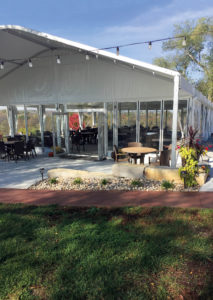
For Krzeminski, choosing a brand comes down to choosing a brand’s human assets.
“The biggest item a tent rental company is paying for is the investment in the brand’s people, who they will be dealing with on a daily and weekly basis,” he says. “The support from the brand is key to any investment in a product line.”
They say you want an evolution
Pollard describes trends in clearspans as more “evolutionary than revolutionary.”
“Things like wall rollers, pulling apparatus—these things don’t change the appearance of the structures but make a huge difference in their convenience and desirability,” he says.
“On the manufacturing side, the innovation is in the precision and reliability of fabrication,” he adds. Pollard makes frequent visits to Cosco’s manufacturing facility in China to see firsthand how the product is manufactured and to ensure quality and consistency, he says. “Most manufacturers use CNC [computer numerical control] fabric cutters, so every top and every wall are identically cut and angles are accurate. Same with the aluminum profiles—CNC lathes now do all the machining. For steel fittings, we are now deploying robotic welders to ensure quality is consistent in every piece.”
Gentsch predicts that code enforcement will play a major role in the development and certification of clearspans, especially with regard to public safety.
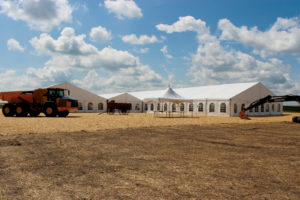
(such as legs, steel fittings, eave beams
and purlins) is an advantage that accrues when parts from different width tents are interchangeable. A large event, such as this plains exhibit of historic and contemporary earth-moving equipment, can quickly be set up using modular parts. Photo courtesy of Special Event Rentals.
“The great thing about clearspans is they are durable, sturdy and can accommodate and meet code for snow loads for temporary or semi-permanent applications, which makes them more versatile than other tents,” he says. “In the future, the U.S. and North American markets are going to see more multistory structures and new designs. As clearspans become more sophisticated and better accepted by architects, this will be a good thing for our industry for end-user permanent and semi-permanent applications. For example, there are two structures that have been up at a hotel in Chicago year round for several years that have withstood Chicago winters because they are snow-loaded for 35 pounds per square foot. There are also tax advantages for these types of clearspan structures because they are not classified as permanent buildings.”
McInnes of HTS agrees that multilevel structures will soon be a common sight at tented events in North America.
“Currently there is real market demand for three-level configurations, as well as demand for structures with asymmetrical builds, with single, double and three levels,” McInnes says, “and for creating stadium seating on upper levels.”
Brancato predicts innovation around roof frame and glass design.

at golf tournaments and other events across the country. Pictured here with horizontal glass and an annex, arcum clearspan is
also available with a roof projection.
Photo courtesy of Losberger De Boer.
“These are two of the most popular design elements for innovation when building a structure,” he says. “We’re also seeing structures getting very large, some up to 200 feet wide. Conversely, more clients are using smaller engineered frame profiles that may have historically been addressed with small frame canopies.”
What do tent rental companies want from clearspan manufacturers? The two biggest items renters are asking for are efficient product design that allows for quick installations with less labor and a low price point, Krzeminski says.
“The quantity and service that is available today in the U.S. market is outstanding,” he says. “The competition between manufacturers, as well as the end-consumer needs and expectations, has driven increases in quality and service. Throughout the entire manufacturing process, companies are using the latest in technology and techniques to ensure the delivery of a quality product—CNC machines, ISO certifications as well as the latest in fabric technology ensures the delivery of quality products for the rental company. There has never been a better time to invest in clearspan product lines. The quantity of quality manufacturers and the low cost of entry is continuing this trend.”
Bruce N. Wright, AIA, is an architect and consultant to designers, architects and related professionals, and a frequent contributor to Specialty Fabrics Review, Fabric Architecture and Advanced Textiles Source.
Ask these questions:
- Does this brand have a good track record within the industry?
- What is the industry’s view of the brand? How does it compare to other brands?
- What is the brand’s value proposition? What makes this brand attractive to customers?
- What is the return on investment for a brand’s products?
- What type of product support does the brand offer? Does this include on-site training, certifications and engineering drawings?
 TEXTILES.ORG
TEXTILES.ORG


